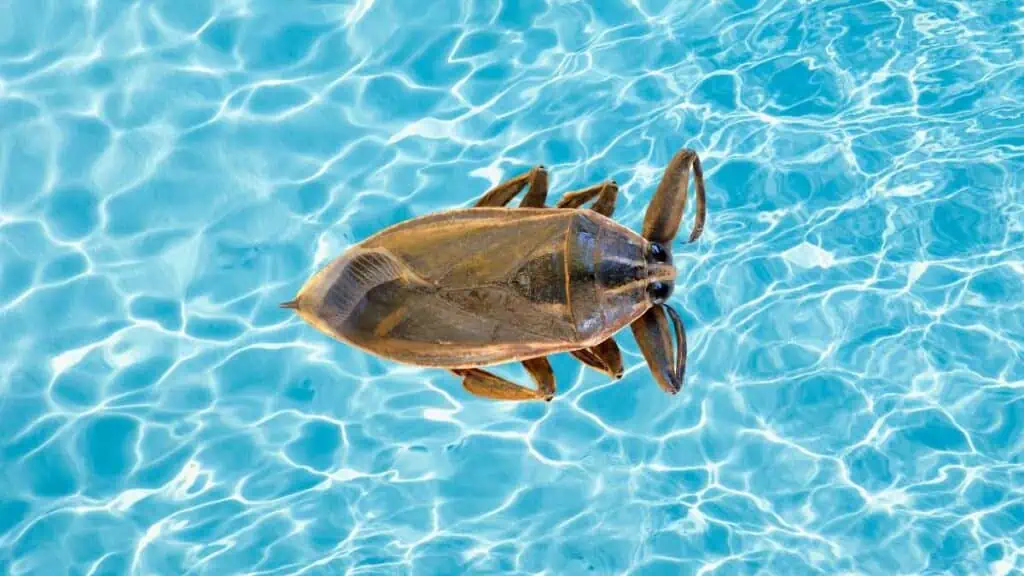Encountering bugs in your swimming pool can be an unpleasant experience.
The most commonly found water bugs in pool water include the water boatman and the backswimmer. Although water boatmen are generally harmless to humans, backswimmers can inflict a painful bite.
A water boatman feeds on algae, while a backswimmer preys on the water boatman and other bugs. Both types of bugs are aquatic, so eliminating their food sources and habitats can help to prevent them from infesting your pool.
Backswimmers are actually a predator of water boatmen – so get rid of the water boatmen and you “kill two bugs with one stone”.
The key to getting rid of water bugs and preventing them from coming back again is to make your pool and the surrounding area completely uninviting to them. Let’s see how.
The bottom line to eliminating water bugs in pool water is:
If you don’t have algae in your pool, you won’t have water boatmen.
If you don’t have water boatmen in your pool, you won’t have backswimmers.

So, how to get rid of water bugs in pool
As the bottom line above states, to get rid of water bugs you need to ensure there is nothing for them to feed on. In this case, that is algae. So if you make your pool algae-free, you will not have water bug problems.
To ensure there is no algae you need to keep a regular cleaning and shock routine.
Just 15 minutes of daily pool maintenance can help control bugs in the pool water and prevent them from returning.
Here is how to ensure your pool water is free of algae.
Thoroughly brush and vacuum
Even if you cannot see any algae in the pool it may be there so scrub the walls, steps ladder etc with a good pool brush, using overlapping strokes.
Then vacuum the floor with a manual pool vacuum cleaner (not a robotic pool cleaner this time) and then backwash your filter.
Shock the pool
Shock chlorination eliminates any organic matter, including algae, in the pool.
Since water boatmen thrive on algae that grow in pools (and lay their eggs on the algae) with low levels of chlorine (around 1.0 to 3.0 ppm), maintaining optimal chlorine levels is crucial. After balancing your pool, the pH levels should range from 7.2 to 7.6.
It’s advisable to shock your pool at least weekly, especially if it’s frequently used. Each shock treatment should enhance the pool’s chlorination levels. While shocking your pool, dissolve the chemical in 5 gallons of water before slowly pouring the mixture directly in front of the return line fitting.
Chlorinate the pool in the late evening, leave the pool pump running overnight and avoid swimming until the chlorine levels are between 1.0 and 3.0 ppm.
The next day you will probably see dead algae lying on the bottom. So you should vacuum again but this time vacuum to waste to make sure algae, dead or alive, are expelled.
Read this article to find out how to remove algae dust.
Algaecide
Eliminating the bugs’ food supply can help manage the infestation. Once you’ve shocked your pool and the chlorine levels have reduced to around 1.0 to 3.0 ppm, apply an algaecide as per the product instructions.
Regular skimming
Skim your pool every day to remove any dead bugs and any live ones you can see swimming around.
Removing dead bugs prevents other bugs from feeding on them and multiplying. Organic matter like leaves and grass can provide shelter for bugs, so regular skimming is crucial.
Other Methods
Use cooking oil and a bucket
This isn’t a method I would use as I have no wish to kill water boatmen, particularly as they eat mosquito larvae and I really hate mosquitoes.
The method is – fill a bucket with pool water and pour some oil into it. As oil floats on water, you can skim the bugs from your pool and place them in the oil-filled bucket. Cover the bucket with a lid and wait for the bugs to die.
Using liquid dish wash detergent
An easy and cost-effective way to manage water bugs is to use liquid dish soap detergent. This method modifies the water’s surface tension, preventing bugs from standing on the water or creating air bubbles underwater.
When vacuuming, they eventually drown and are filtered out by the pool’s filtration system.
Instructions:
- Add 3 tablespoons of liquid dish detergent to a spray bottle.
- Fill the rest of the spray bottle with water and mix thoroughly.
- Directly spray the solution on any groupings of water bugs you can find.
- Also spray the solution along the perimeter of the swimming pool.
- Wait for a few hours.
The bugs will have drowned and will be removed by the pool filtration system. Repeat this process as needed. Dish soap biodegrades and is pH balanced, so small quantities will not harm your pool.
If these methods do not effectively manage the water bugs in your swimming pool, consider consulting a pool professional for further assistance. Best of luck!
FAQs
What are the common types of water bugs in swimming pools?
The water boatman and the backswimmer are the most common types of swimming pool bugs.
What is the role of chlorination in managing water bugs?
Chlorination kills any organic matter in the pool, including algae, which is a primary food source for water bugs. Maintaining optimal chlorine levels can help prevent bug infestations.
Why is regular brushing and vacuuming important in controlling water bugs?
Regular brushing and vacuuming help remove algae, which is a food source for water bugs, and also removes dead bugs, preventing them from becoming food for other bugs.
Do backswimmer water bugs bite?
Yes, backswimmers will bite humans if they are annoyed. They can give a bite rather like a wasp sting.
Do pool water boatmen bite?
Water boatmen in a swimming pool are completely harmless and do not bite.





Leave a Reply